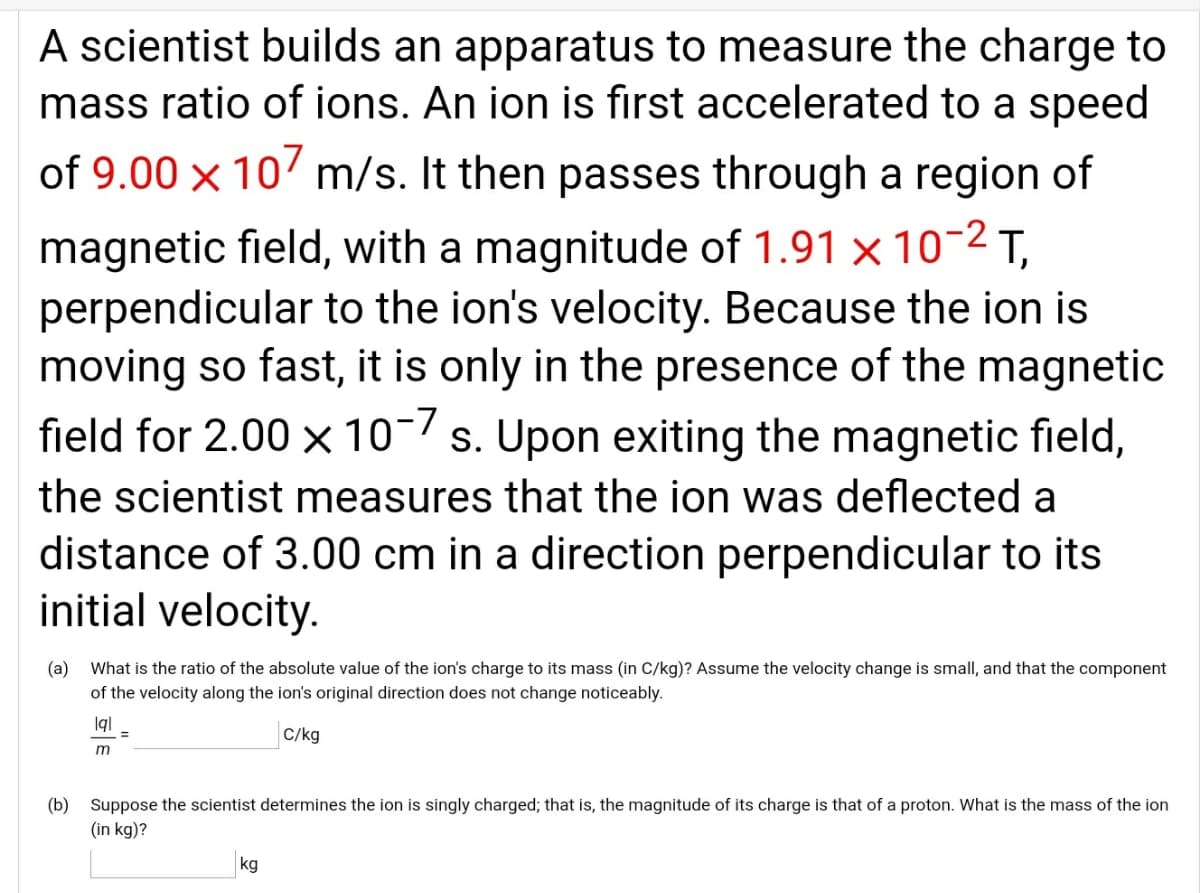A scientist builds an apparatus to measure the charge to mass ratio of ions. An ion is first accelerated to a speed of 9.00 x 10' m/s. It then passes through a region of magnetic field, with a magnitude of 1.91 × 10-2 T, perpendicular to the ion's velocity. Because the ion is moving so fast, it is only in the presence of the magnetic field for 2.00 x 10-/ s. Upon exiting the magnetic field, the scientist measures that the ion was deflected a distance of 3.00 cm in a direction perpendicular to its initial velocity. (a) What is the ratio of the absolute value of the ion's charge to its mass (in C/kg)? Assume the velocity change is small, and that the component of the velocity along the ion's original direction does not change noticeably. C/kg %3D m (b) Suppose the scientist determines the ion is singly charged; that is, the magnitude of its charge is that (in kg)? a proton. What is the mass of the ion kg
A scientist builds an apparatus to measure the charge to mass ratio of ions. An ion is first accelerated to a speed of 9.00 x 10' m/s. It then passes through a region of magnetic field, with a magnitude of 1.91 × 10-2 T, perpendicular to the ion's velocity. Because the ion is moving so fast, it is only in the presence of the magnetic field for 2.00 x 10-/ s. Upon exiting the magnetic field, the scientist measures that the ion was deflected a distance of 3.00 cm in a direction perpendicular to its initial velocity. (a) What is the ratio of the absolute value of the ion's charge to its mass (in C/kg)? Assume the velocity change is small, and that the component of the velocity along the ion's original direction does not change noticeably. C/kg %3D m (b) Suppose the scientist determines the ion is singly charged; that is, the magnitude of its charge is that (in kg)? a proton. What is the mass of the ion kg
Related questions
Question

Transcribed Image Text:A scientist builds an apparatus to measure the charge to
mass ratio of ions. An ion is first accelerated to a speed
of 9.00 x 10 m/s. It then passes through a region of
magnetic field, with a magnitude of 1.91 × 10-2 T,
perpendicular to the ion's velocity. Because the ion is
moving so fast, it is only in the presence of the magnetic
field for 2.00 x 10-7 s. Upon exiting the magnetic field,
the scientist measures that the ion was deflected a
distance of 3.00 cm in a direction perpendicular to its
initial velocity.
(a)
What is the ratio of the absolute value of the ion's charge to its mass (in C/kg)? Assume the velocity change is small, and that the component
of the velocity along the ion's original direction does not change noticeably.
C/kg
(b) Suppose the scientist determines the ion is singly charged; that is, the magnitude of its charge is that of a proton. What is the mass of the ion
(in kg)?
kg
Expert Solution
This question has been solved!
Explore an expertly crafted, step-by-step solution for a thorough understanding of key concepts.
This is a popular solution!
Trending now
This is a popular solution!
Step by step
Solved in 5 steps with 1 images
